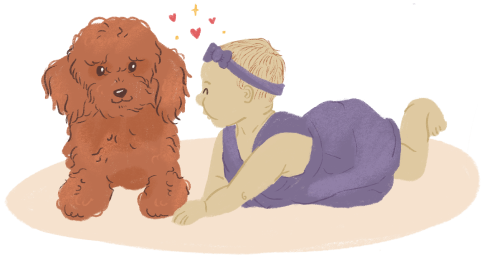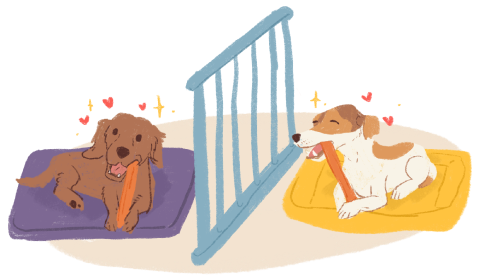How to Manage Multiple Dogs in One Household and Reduce Conflicts

Living with multiple dogs can be rewarding but requires understanding canine behaviour to maintain harmony. While most dogs cohabit peacefully if treated equally, there can be occasional tension. Recognising dog body language and knowing how to prevent stress and anxiety are crucial for a happy multi-dog household.
Recognising Dog Body Language and Stress Cues
Dogs primarily communicate through body language. Learning to spot signs of stress and anxiety early can help you prevent conflicts. Minor squabbles are normal and usually occur over toys, food, or even your attention. These are often brief and can be interrupted with a calm command like "Stop that!"
Common Reasons for Dog Disputes
Resource guarding is one of the primary causes of tension in multi-dog homes, where a dog defends food, toys, or even a favoured person. Other common issues include younger dogs crowding older ones, physical pain, and anxiety disorders. Watching for subtle body language cues can alert you to rising tension.
Once fighting becomes a regular occurrence in your multiple dog household due to the constant presence of stressful situations (stressors), triggers can be born from these stressors that will then readily set off fighting.
Triggers that set off fighting can be many different things in multiple dog households and can include:
- Changes in Household Dynamics: Adding a new dog, family member, baby, or moving homes can alter the group dynamic. For tips to help your situation if you are expecting a baby and currently have a dog, or multiple dogs, click HERE.
- Routine Disruptions: Changes in schedule can increase anxiety.
- High-Activity Situations: Loud noises, doorbells, or unfamiliar guests can overstimulate dogs.

Reducing Tension Through Trigger Management
One of the best ways to reduce conflict is to manage the situations that might trigger it.
You can do this in several ways:
- Avoiding Triggers: Prevent dogs from facing certain situations that may upset them.
- Removing Triggers: If possible, eliminate stressful factors entirely.
- Counter Conditioning: Change how your dog's feel about certain triggers by pairing them with positive experiences, like a treat or favourite toy. This approach helps dogs see triggers as something positive rather than stressful.
Establishing Household Rules and Training
Along with managing stressors, setting consistent rules is crucial in a multi-dog home. This helps all dogs understand boundaries and reduces potential conflicts. Here are some helpful practices:

- Equal Attention: Treat all dogs fairly to avoid jealousy.
- Designate Quiet Zones for Senior Dogs: Older dogs may need more space and downtime.
- Basic Obedience Training: Teach each dog to respond to commands like "sit" and "come." This provides better control when managing their behaviour.
- Manage Resources Carefully: Limit access to high value items and use baby gates to create safe separations when necessary.
- Crate Training: Provide each dog with a crate as a personal retreat, which can also aid in preventing disputes. Learn how to crate train your dog HERE.
- Separate Feeding Areas: Feed dogs individually if conflicts arise during mealtime to reduce competition.
- Address behaviour problems as soon as they start.
- Do not punish - Yelling at your dog, exerting dominance or trying to force them to give up something they consider valuable, can make the problem worse.
It is imperative that all members of the family follow and enforce the rules with all the dogs as inconsistencies will only increase stress which may set off more fights.
When dogs resource guard over food
When it comes to dogs that fight or resource guard over food or treats, again, it's important to manage the environment and situations you put your dogs in.
My two dogs have no problem with being fed next to each other, but Vindi can be prone to resource guarding long lasting chews. He can sit with it under his paw for quite some time, so I always make sure I feed the chews when I am around and able to ensure that my smaller, older one Darcy doesn’t try to get too close, or rather, try to steal Vindi’s chew when he isn’t looking - which he has done a few times, likely causing Vindi’s resource guarding over this high value treat.

If this is the case in your household, whether it be over their meals or treats, or you have introduced a new dog or puppy into the family, I always suggest erring on the side of caution and feeding your dogs in a separate area. Baby gates are a good way to keep them apart, but so they can still see and hear each other and (hopefully) learn to eat calmly near each other under supervision in the future.
When it comes to resource guarding of you or other people, make sure you or others aren’t reinforcing it by laughing, patting, giving them extra attention or goading them further.
When Conflicts Escalate
If fights become intense or more frequent, you should consult an experienced trainer who specialises in multi-dog households.
Addressing issues early can prevent conflicts from escalating. Ignoring problems often leads to worsening behaviour, and eventually, permanent separation may be needed within the household. Early intervention, balanced attention, and structure are key to a harmonious multi-dog home.

About the Author
Lara Shannon is a certified dog behaviourist and trainer, pet food nutrition specialist, Executive Producer and Host of Pooches at Play on Channel 10 and editor of Poochesatplay.com. Lara also runs her own dog training business in Melbourne’s Bayside area and is the Author of World of Dogs and Eat, Play, Love Your Dog
